The Features of Native Gold in Ore-Bearing Breccias with Realgar-Orpiment Cement of the Vorontsovskoe Deposit (Northern Urals, Russia)
Abstract
:1. Introduction
2. Geological Setting
2.1. Regional Geological Setting
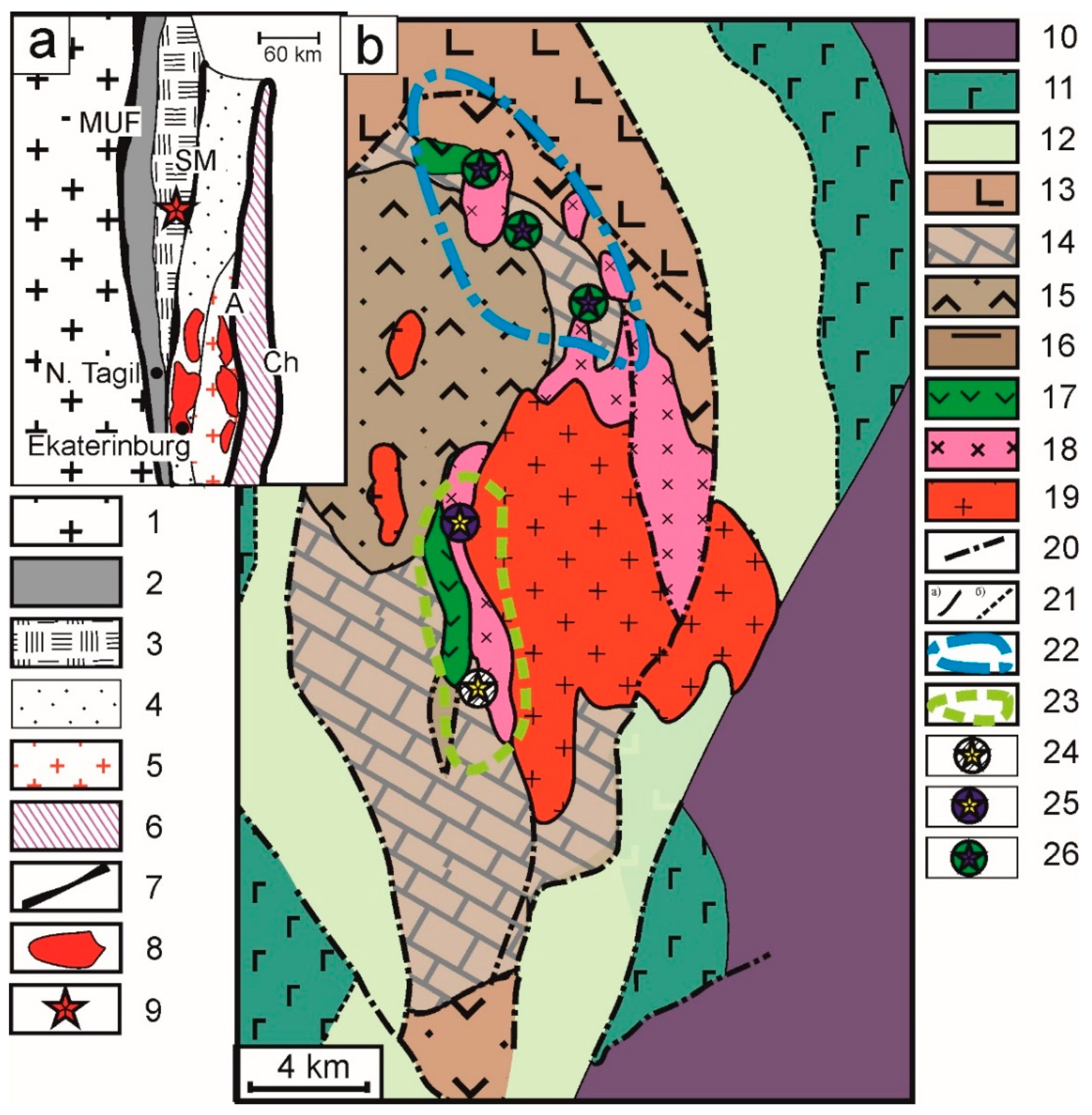
2.2. Local Geological Setting
3. Materials and Methods
3.1. Sample Collection and Preparation
3.2. Analytical Methods
4. Results
4.1. Mineral Composition of the Breccias
4.2. Morphological Features of Native Gold in Breccias
4.3. Chemical Composition of Native Gold
4.4. Chemical Composition of Native Gold–A Comparison
5. Discussion
6. Conclusions
Author Contributions
Funding
Acknowledgments
Conflicts of Interest
References
- Minina, O.V. Auerbakh complex ore-magmatic system in the Middle Urals. Natl. Geol. 1994, 7, 17–23. (In Russian) [Google Scholar]
- Zavaritsky, A.N. Geological outline of copper ore deposits in the Urals. Part 2. In Materials on General and Applied Geology; Publishing House of the Geological Committee: St. Petersburg, Russia, 1929; p. 179. (In Russian) [Google Scholar]
- Petrov, G.A.; Zhiganov, A.A.; Stefanovsky, V.V.; Shalaginov, V.V.; Petrova, T.E.; Ovchinnikov, R.A.; Gertman, T.A. State Geological Map of the Russian Federation; Scale 1: 1,000,000 (Third Generation); Ural Series; Sheet O-41 (Ekaterinburg); Publishing House of VSEGEI: Saint-Petersburg, Russia, 2011; p. 492. (In Russian) [Google Scholar]
- Naumov, E.A.; Borovikov, A.A.; Borisenko, A.S.; Zadorozhniy, M.V.; Murzin, V.V. Physicochemical conditions of formation of epithermal gold-mercury deposits. Geol. Geofiz. 2002, 43, 1003–1013. [Google Scholar]
- Sazonov, V.N.; Murzin, V.V.; Grigoriev, N.A. Vorontsovskoe gold deposit—An example of mineralization of the Carlin type in the Urals, Russia. Geol. Ore Depos. 1998, 40, 157–170. (In Russian) [Google Scholar]
- Murzin, V.V.; Naumov, E.A.; Azovskova, O.B.; Varlamov, D.A.; Rovnushkin, M.Y.; Pirajno, F. The Vorontsovskoe Au-Hg-As ore deposit (Northern Urals, Russia): Geological setting, ore mineralogy, geochemistry, geochronology and genetic model. Ore Geol. Rev. 2017, 85, 271–298. [Google Scholar] [CrossRef]
- Vikentiev, I.V.; Tyukova, E.Y.; Murzin, V.V.; Vikentieva, O.V.; Pavlov, L.G. Vorontsovskoe gold deposit. In Geology Forms of Gold, Genesis; Fort Dialog-Iset: Ekaterinburg, Russia, 2016; p. 206. (In Russian) [Google Scholar]
- Vikentev, I.V.; Tyukova, E.E.; Vikenteva, O.V.; Chugaev, A.V.; Dubinina, E.O.; Prokof’ef, V.Y.; Pavlov, L.G.; Murzin, V.V. Vorontsovka Carlin-style gold deposit in the North Urals: Mineralogy, fluid inclusion and isotope data for genetic model. Chem. Geol. 2018, 408, 144–166. [Google Scholar] [CrossRef]
- Stepanov, S.Y.; Sharpyonok, L.N.; Antonov, A.V. Fluid-explosive breccia of the Vorontsovskoe gold deposit (Northern Urals). Zapiski RMO 2017, 146, 29–43. (In Russian) [Google Scholar]
- Rakhov, E.V. The Ore-Bearing Breccia of Vorontsovskoe Deposit: Structure, Genesis and Role in the Formation of Gold Mineralization. Ph.D. Thesis, The Zavaritsky Institute of Geology and Geochemistry, Ekaterinburg, Russia, 1999. (In Russian). [Google Scholar]
- Endogenic Ore-Bearing Breccias. Methodological Reccomendations on the Identification of Endogenic Breccias of Different Genetic Types and Their Potential Ore-Bearance Evaluating in Relation to the Tasks of State Geological Mapping; VSEGEI Press: Saint Petersburg, Russia, 2018; p. 104. (In Russian) [Google Scholar]
- Krasnobaev, A.A.; Fershtater, G.B.; Bogomolov, E.S.; Larionov, A.N.; Berezhnaya, N.G. Auerbakch Massif: Zircons, Age, Polychronicity; Yearbook 2006; IGG UrB RAS: Ekaterinburg, Russia, 2007; pp. 191–196. (In Russian) [Google Scholar]
- Fershtater, G.B. Paleozoic Intrusive Magmatism of the Middle and Southern Urals; Publishing House of RIO UB RAS: Ekaterinburg, Russia, 2013; p. 368. (In Russian) [Google Scholar]
- Korzhinsky, D.S. Petrology of the Turyinsky Skarn Copper Deposits; Publishing House of RAS: Moscow, Russia, 1948; p. 148. (In Russian) [Google Scholar]
- Cheremisin, A.A.; Zlotnik-Hotkevich, A.G. Vorontsovskoe gold deposit. Ores Met. 1997, 1, 59–70. (In Russian) [Google Scholar]
- Kasatkin, A.V.; Stepanov, S.Y.; Tsyganko, M.V.; Škoda, R.; Nestola, F.; Plášil, J.; Makovicky, E.; Agakhanov, A.A.; Palamarchuk, R.S. Mineralogy of the Vorontsovskoe gold deposit (Northern Urals). Part 1: History of study, mineral assemblages, list of minerals. Mineralogy 2020, 6, 3–34. (In Russian) [Google Scholar]
- Kasatkin, A.V.; Stepanov, S.Y.; Tsyganko, M.V.; Škoda, R.; Nestola, F.; Plášil, J.; Makovicky, E.; Agakhanov, A.A.; Palamarchuk, R.S. Mineralogy of the Vorontsovskoe gold deposit (Northern Urals). Part 2: Native elements, sulfides, arsenides, tellurides. Mineralogy 2021, 7, 5–22. (In Russian) [Google Scholar]
- Townley, B.K.; Herail, G.; Maksaev, V.; Palacios, C.; Parseval, P.; Sepulveda, F.; Jrelana, R.; Rivas, P.; Ulloa, C. Gold grain morphology and composition as an exploration tool: Application to gold exploration in covered areas. Geochem. Explor. Environ. Anal. 2003, 3, 29–38. [Google Scholar] [CrossRef] [Green Version]
- Murzin, V.V.; Sazonov, V.N.; Ronkin, Y.L. Model for the formation of the Vorontsovskoe gold deposit in the Urals (Carlin type): New data and problems. Lithosphere 2010, 6, 66–73. (In Russian) [Google Scholar]
- Murzin, V.V.; Sazonov, V.N. Mineral Associations and Conditions for the Formation of Sulfide Gold-Bearing Ores of the Turyinsko-Auerbakh Ore Field (the Urals); Publishing House of UrB RAS: Ekaterinburg, Russia, 1995; p. 98. (In Russian) [Google Scholar]
- Emsbo, P.; Hofstra, A.H.; Lauhna, E.A.; Griffin, C.L.; Hutcinson, R.W. Origin of High-Grade Gold Ore, Source of Ore Fluid Components, and Genesis of the Meikle and Neighboring Carlin-Type Deposits, Northern Carlin Trend, Nevada. Econ. Geol. 2003, 98, 1069–1105. [Google Scholar] [CrossRef]
- Radtke, A. Geology of the Carlin Gold Deposit, Nevada; USGS Professional Paper 1267; USGS: Reston, VA, USA, 1985; p. 124. [Google Scholar]
- Muntean, J.L.; Cline, J.S. Diversity of carlin-style gold deposit. Rev. Econ. Geol. 2018, 20, 1–7. [Google Scholar]
- Hettmann, K.; Kressig, K.; Rehkamper, M.; Wenzel, T.; Mertz-Kraus, R.; Markl, G. Thallium geochemistry in the metamorphic Lengenbach sulfide deposit, Switzerland: Thallium-isotope fractionation in a sulfide melt. Am. Mineral. 2014, 99, 793–803. [Google Scholar] [CrossRef]
- Raber, T.; Roth, P. The Lengenbach Quarry in Switzerland: Classic Locality for Rare Thallium Sulfosalts. Minerals 2018, 8, 409. [Google Scholar] [CrossRef] [Green Version]
- Hofmann, B.A.; Knill, M.D. Geochemistry and genesis of the Lengenbach Pb-Zn-As-Tl-Ba-mineralization, Binn Valley, Switzerland. Miner. Depos. 1996, 31, 319–339. [Google Scholar] [CrossRef]
- Janković, S.; Jelenković, R. Thallium mineralization in the Allchar Sb–As–Tl–Au deposit. Neues Jahrb. Fur Mineral. 1994, 167, 283–297. [Google Scholar]
- Volkov, A.V.; Serafimovskiy, T.; Kochneva, N.T.; Tomson, I.N.; Tasaev, G. Alshar Au-As-Sb-Tl epithermal deposit (Southern Macedonia). Geol. Ore Depos. 2006, 48, 205–224. (In Russian) [Google Scholar] [CrossRef]
- Palinkaš, S.; Hofstra, A.H.; Percival, T.J.; Borojevic Šoštaric, S.; Palinkaš, L.; Bermanec, V.; Pecskay, Z.; Boev, B. Comparison of the Allchar Au-As-Sb-Tl deposit, Republic of Macedonia, with Carlin-type gold deposits. Rev. Econ. Geol. 2018, 20, 335–363. [Google Scholar]
- Johan, Z.; Mantienne, J. Thallium-rich mineralization at Jas Roux, Hautes-Alpes, France: A complex epithermal, sediment-hosted, ore-forming system. J. Czech Geol. Soc. 2000, 45, 63–77. [Google Scholar]
- Sillitoe, R.H.; Bonham, H.F. Sediment-hosted gold deposits: Distal products of magmatic-hydrothermal systems. Geology 1990, 18, 157–161. [Google Scholar] [CrossRef]
- Cline, J.S.; Stuert, F.M.; Hofstra, A.H.; Premo, W.; Riciputi, L.; Tosda, R.M.; Tretbar, D.R. Multiple sources of ore-fluid components at the Getchell Carlin-type gold deposit, Nevada, USA. In Proceedings of the Mineral Exploration and Sustainable Development, Seventh Biennial SGA Meeting, Athens, Greece, 24–28 August 2003; Volume 2, pp. 965–968. [Google Scholar]
- Cline, J.S.; Hofstra, A.H.; Muntean, J.L.; Tosdal, R.M.; Hickey, K. Carlin-type deposits in Nevada: Critical geological characteristics and viable models. Econ. Geol. 2005, 100, 371–405. [Google Scholar]
- Kasatkin, A.V.; Nestola, F.; Agakhanov, A.A.; Skoda, R.; Karpenko, V.Y.; Tsyganko, M.V.; Plasil, J. Vorontsovite, (Hg5Cu)Σ6TlAs4S12, and Ferrovorontsovite, (Fe5Cu)Σ6TlAs4S12: The Tl- and Tl-Fe-Analogues of Galkhaite from the Vorontsovskoe Gold Deposit, Northern Urals, Russia. Minerals 2018, 8, 185. [Google Scholar] [CrossRef] [Green Version]
- Kasatkin, A.V.; Makovicky, E.; Plasil, J.; Skoda, R.; Agakhanov, A.A.; Karpenko, V.Y.; Nestola, F. Tsygankoite, Mn8Tl8Hg2(Sb21Pb2Tl)Σ24S48, a New Sulfosalt from the Vorontsovskoe Gold Deposit, Northern Urals, Russia. Minerals 2018, 8, 218. [Google Scholar] [CrossRef] [Green Version]
- Kasatkin, A.V.; Makovicky, E.; Plášil, J.; Škoda, R.; Chukanov, N.V.; Stepanov, S.Y.; Agakhanov, A.A.; Nestola, F. Gladkovskyite, MnTlAs3S6, a new thallium sulfosalt from the Vorontsovskoe gold deposit, Northern Urals, Russia. J. Geosci. 2019, 64, 207–218. [Google Scholar] [CrossRef]
- Kasatkin, A.V.; Makovicky, E.; Plasil, J.; Skoda, R.; Agakhanov, A.A.; Stepanov, S.Y.; Palamarchuk, R.S. LuborŽákite, Mn2AsSbS5, a new member of pavonite homologous series from Vorontsovskoe gold deposit, Northern Urals, Russia. Mineral. Mag. 2020, 84, 738–745. [Google Scholar] [CrossRef]
- Kasatkin, A.V.; Makovicky, E.; Plášil, J.; Škoda, R.; Agakhanov, A.A.; Tsyganko, M.V. Pokhodyashinite, IMA 2019–130. CNMNC Newsletter No. 55. Mineral. Mag. 2020, 84, 485–488. [Google Scholar] [CrossRef]
- Kasatkin, A.V.; Plášil, J.; Makovicky, E.; Chukanov, N.V.; Škoda, R.; Agakhanov, A.A.; Tsyganko, M.V. Gungerite, IMA 2020-009. CNMNC Newsletter No. 56. Eur. J. Mineral. 2020, 32, 443–448. [Google Scholar] [CrossRef]
- Kasatkin, A.V.; Plášil, J.; Makovicky, E.; Chukanov, N.V.; Škoda, R.; Agakhanov, A.A.; Stepanov, S.Y.; Palamarchuk, R.S. Auerbakhite, MnTl2As2S5, a new thallium sulfosalt from the Vorontsovskoe gold deposit, Northern Urals, Russia. J. Geosci. 2021, 66. [Google Scholar] [CrossRef]
- Palyanova, G.A. Gold and Silver Minerals in Sulfide ore. Geol. Ore Depos. 2020, 62, 383–406. [Google Scholar] [CrossRef]
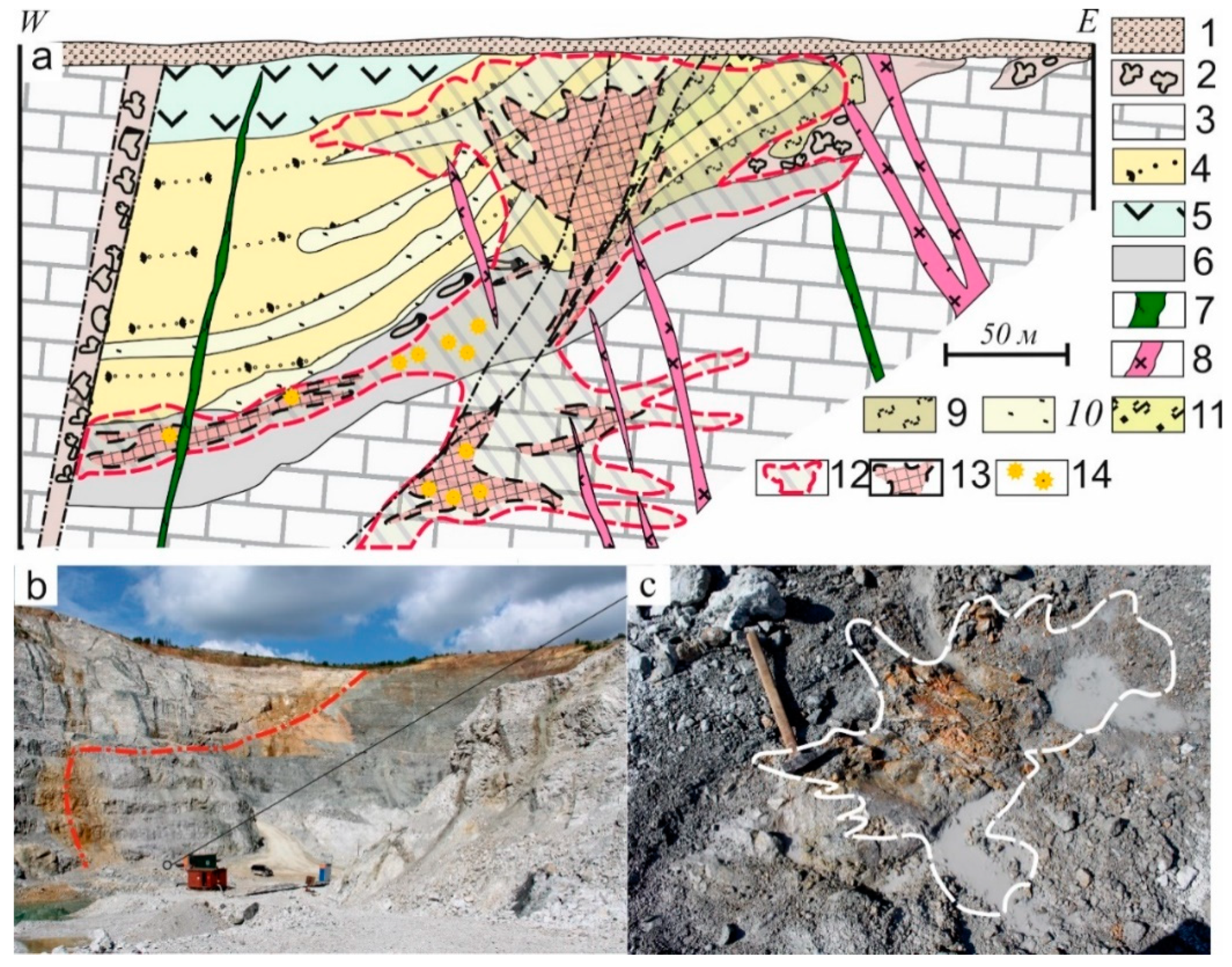
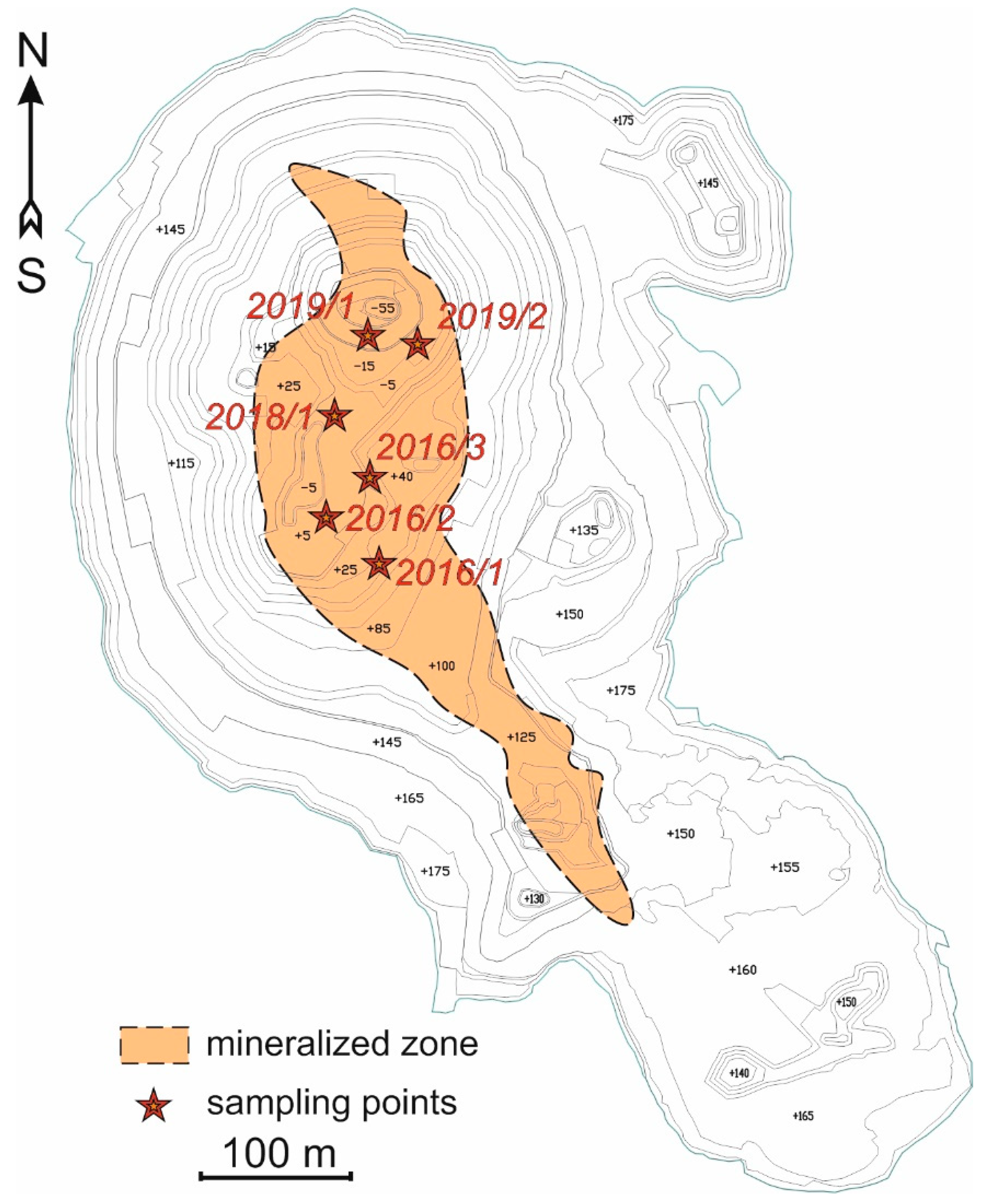
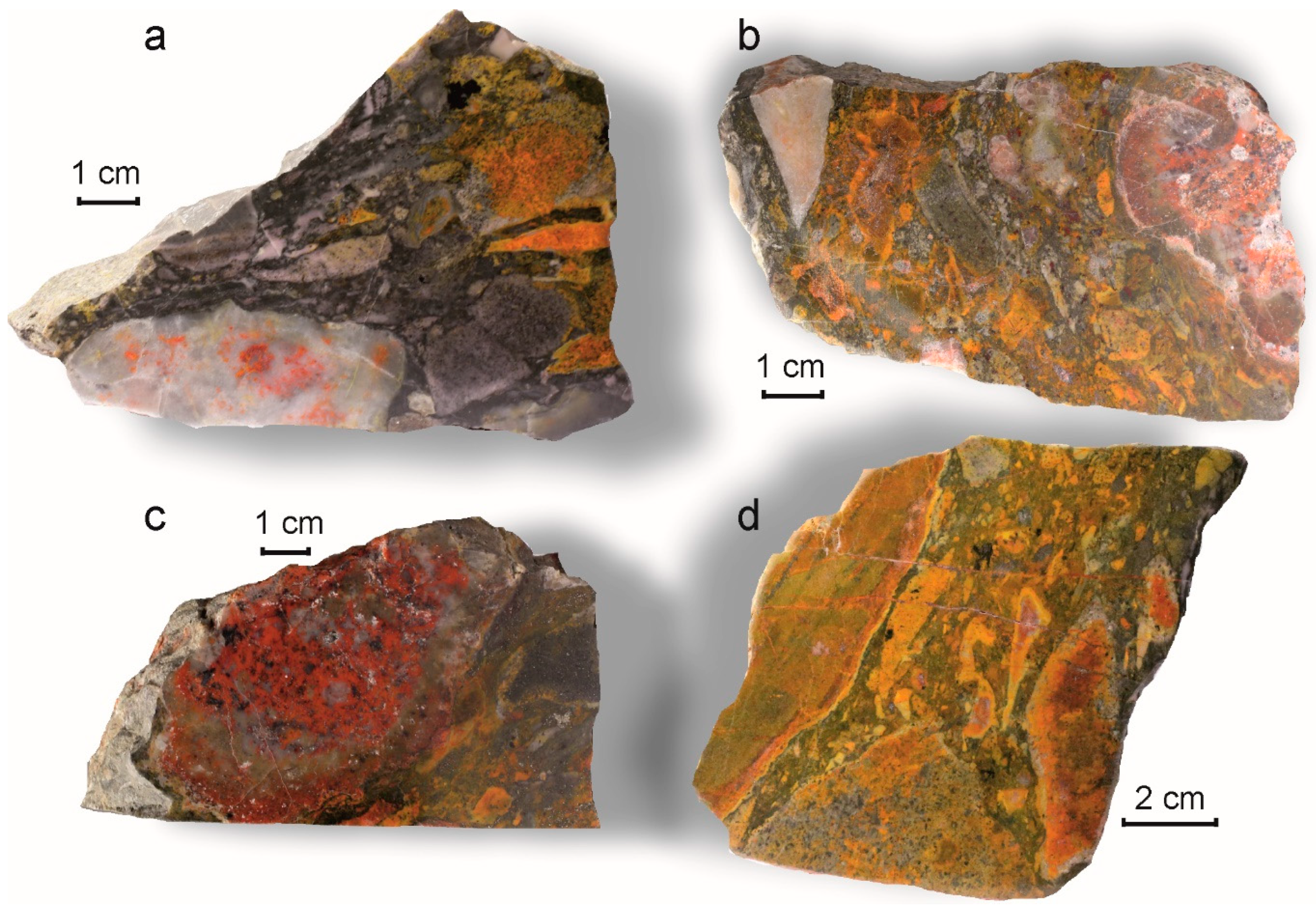
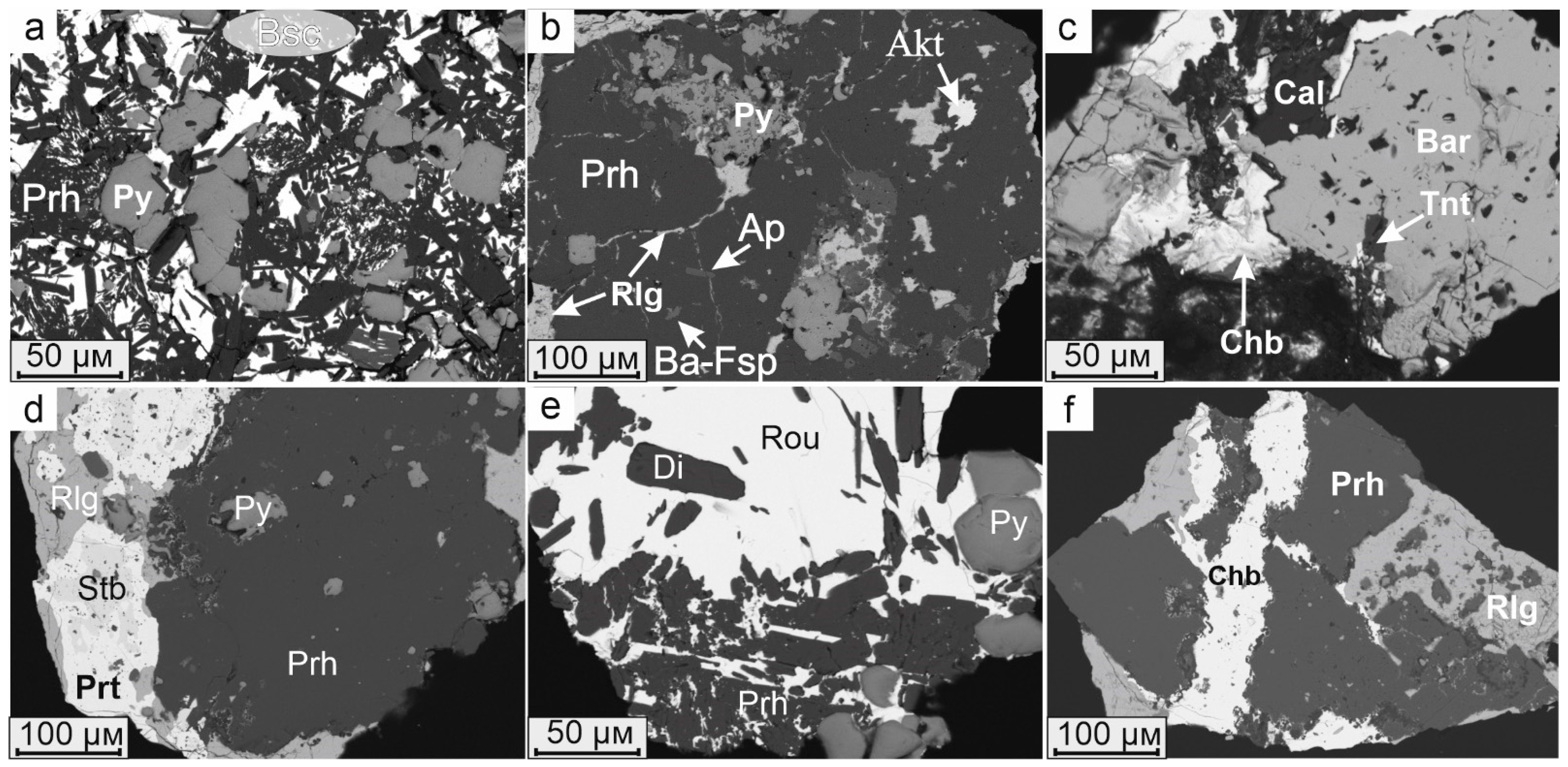
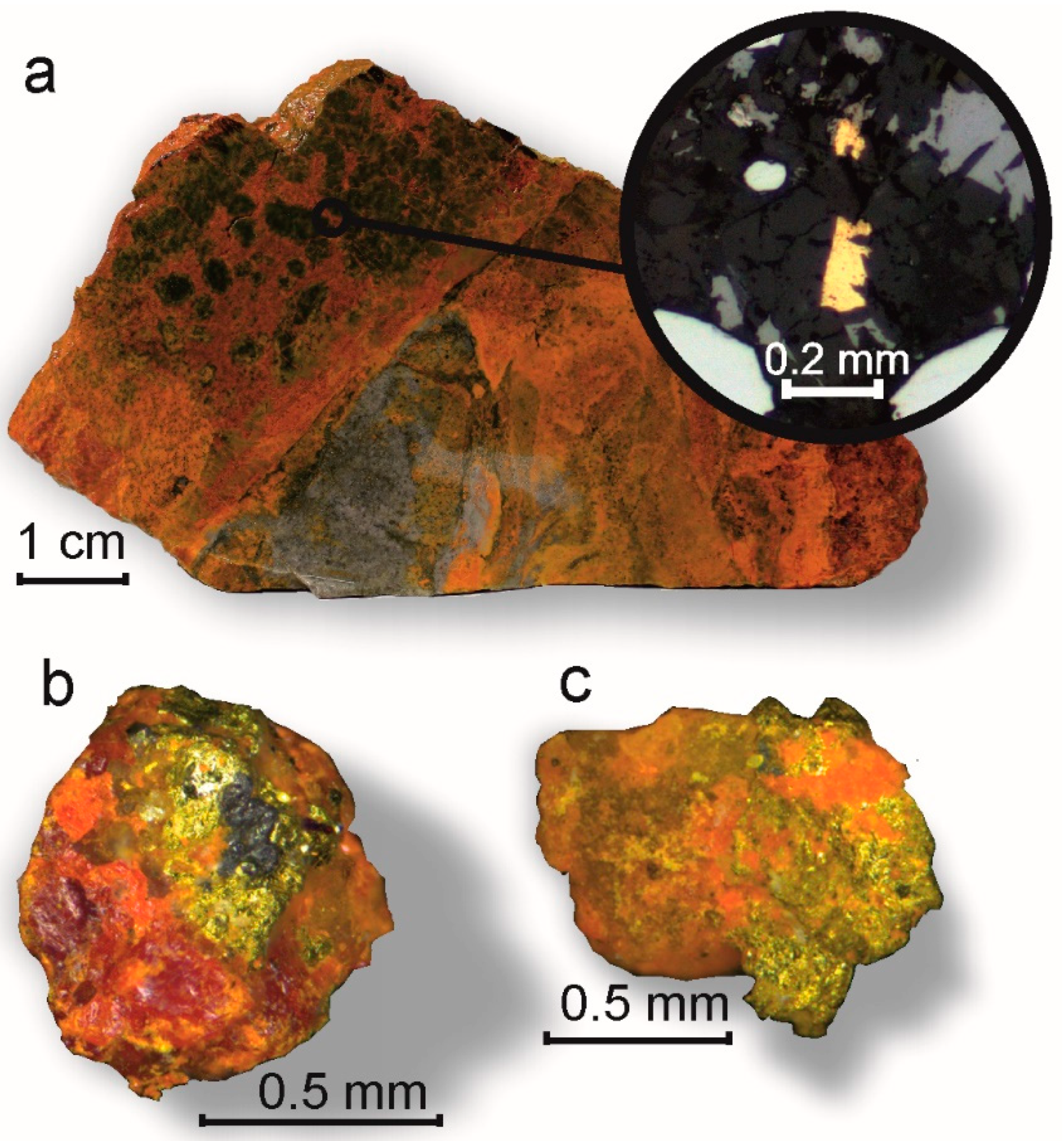

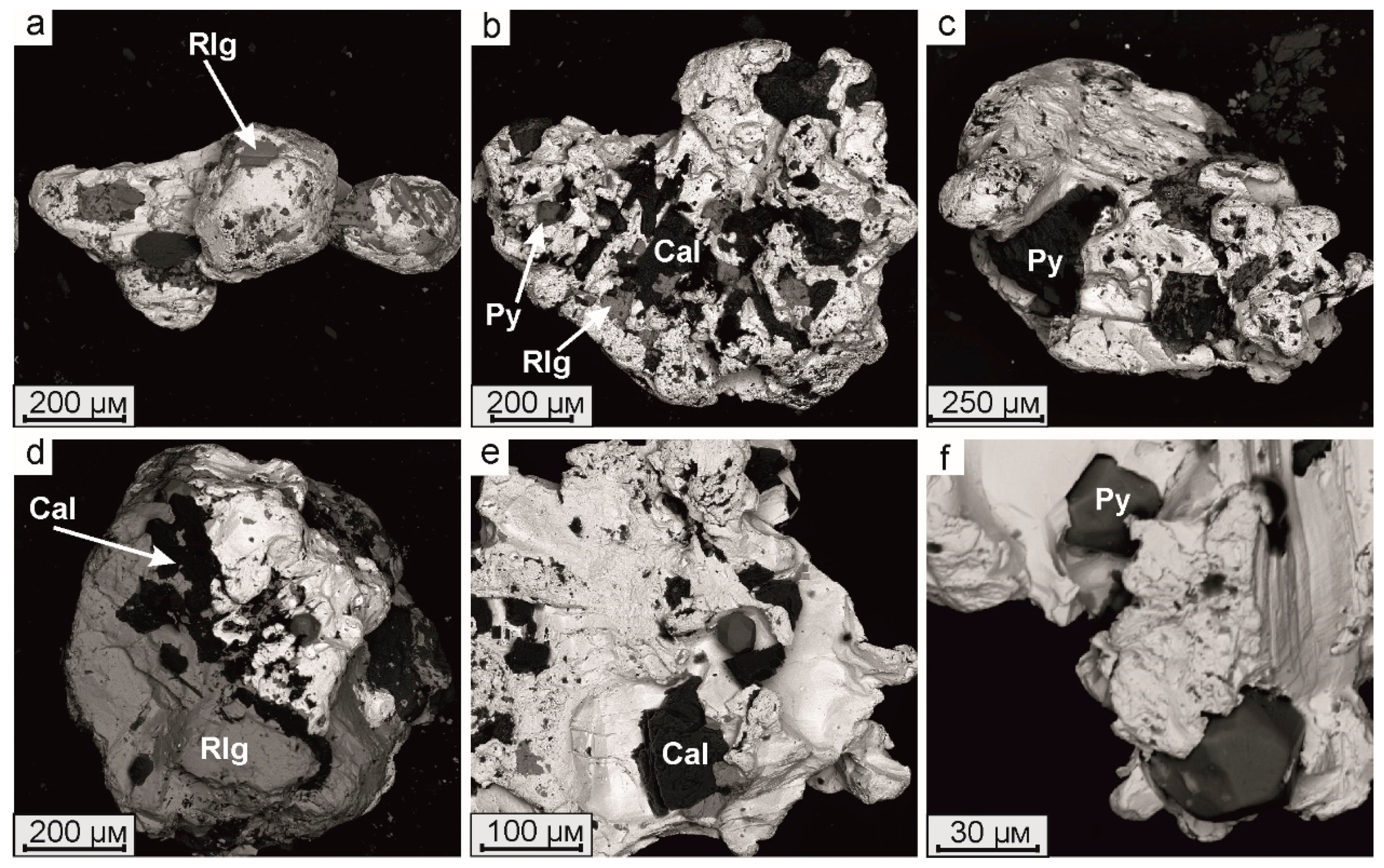

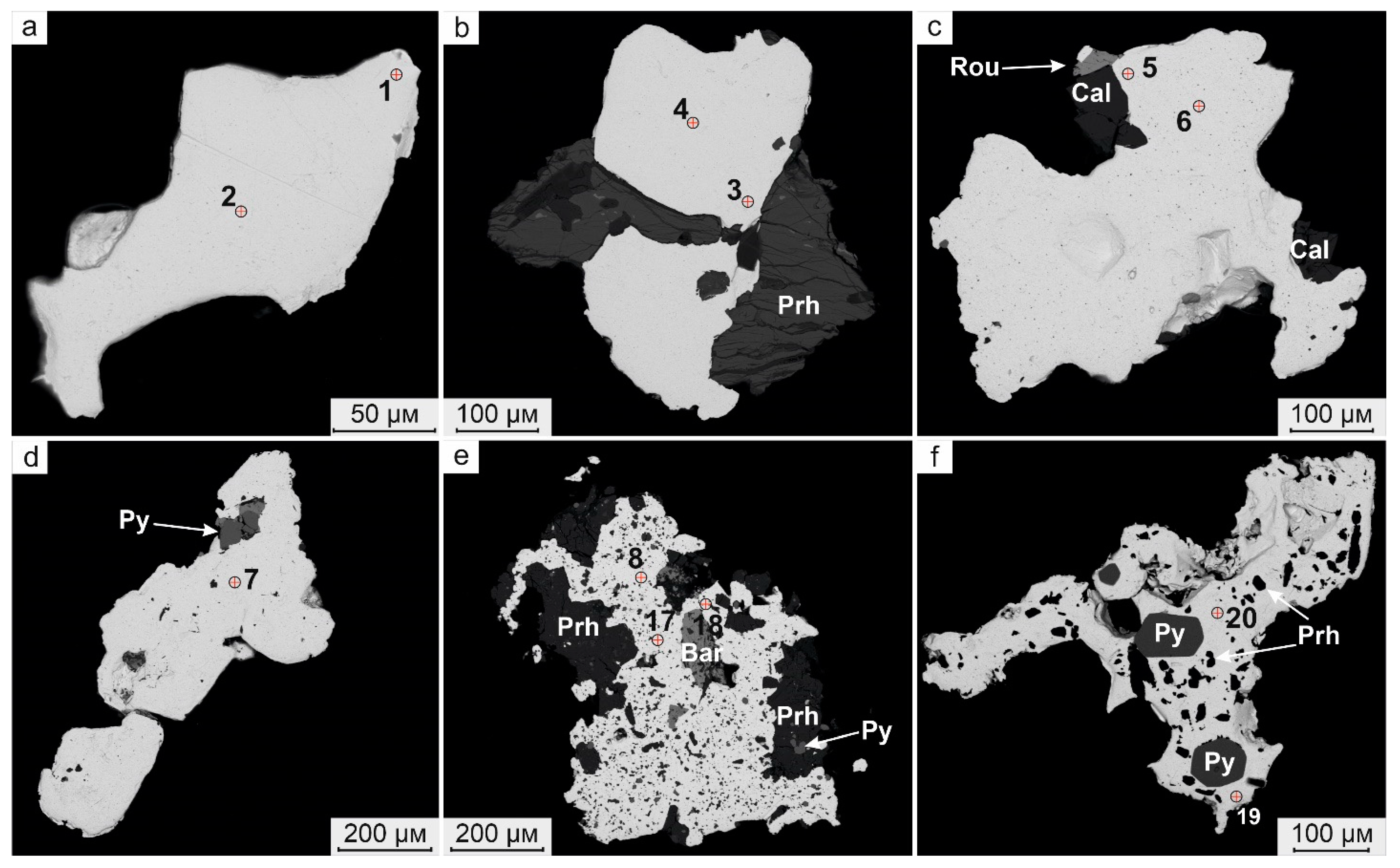
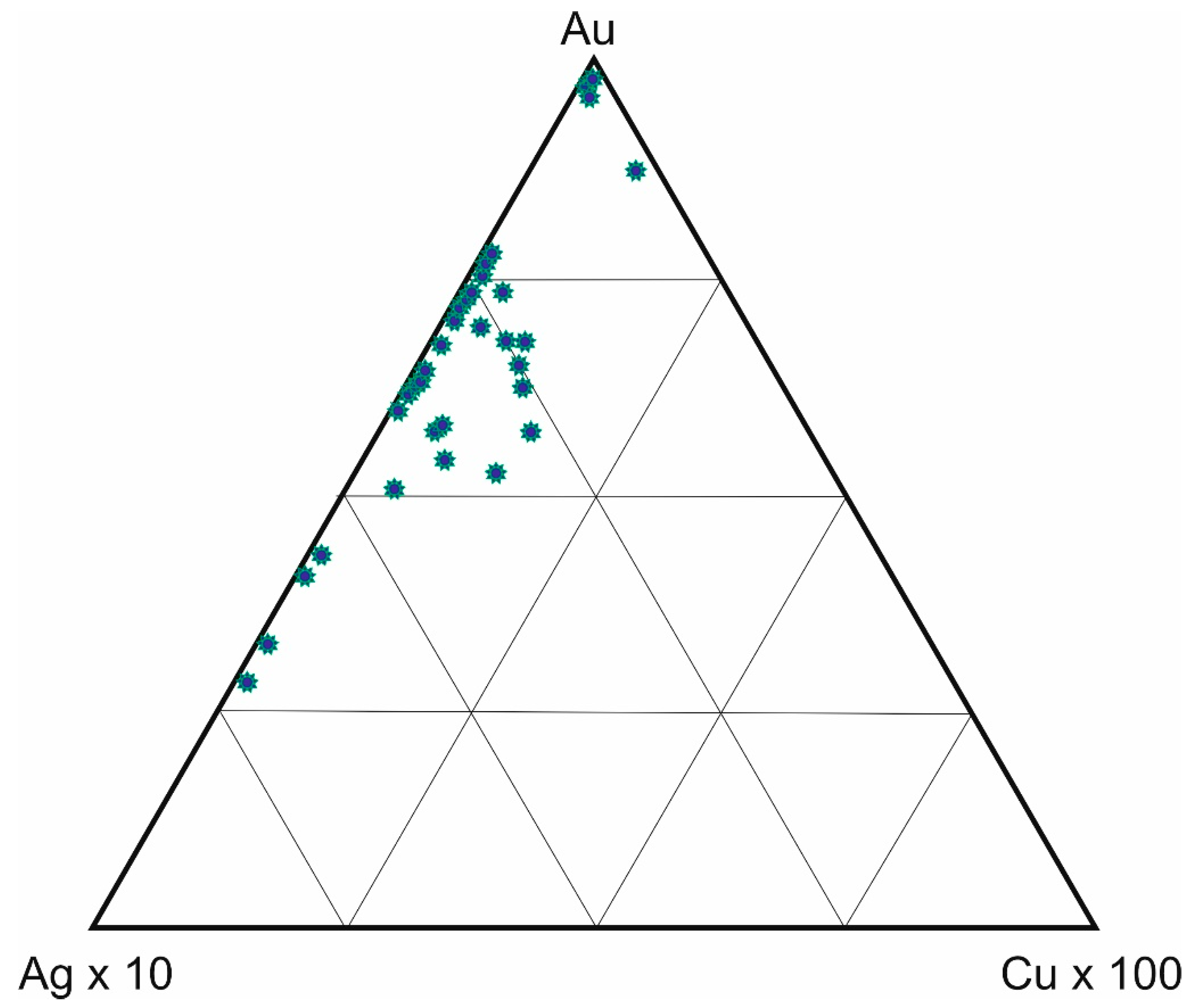
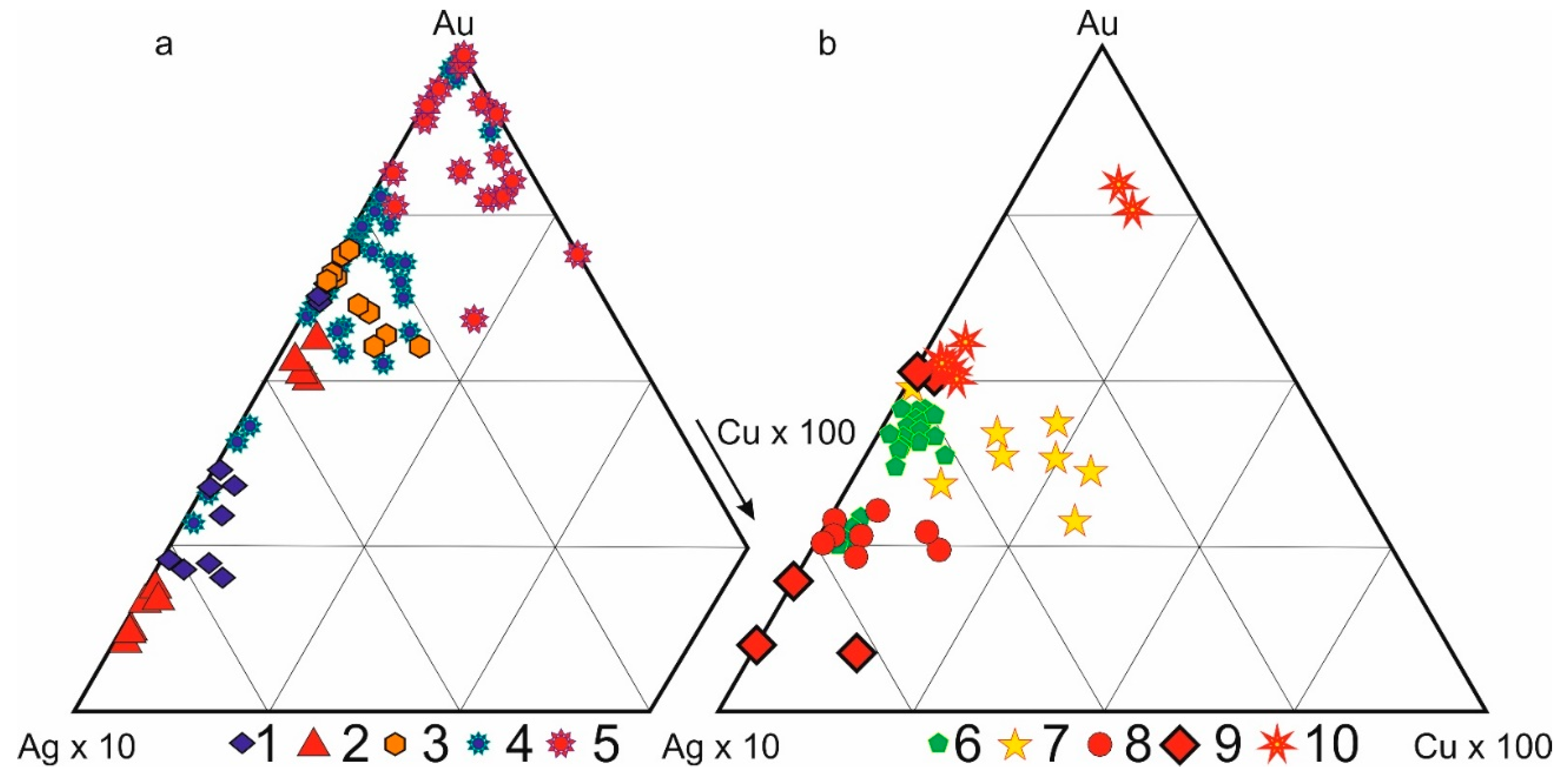
| № | Fe | Cu | Ag | Hg | Tl | Pb | As | Sb | S | Total | Mineral |
|---|---|---|---|---|---|---|---|---|---|---|---|
| 1 | 1.58 | 25.48 | - | 24.29 | - | - | 19.80 | 0.49 | 25.45 | 99.85 | Aktashite |
| 2 | - | - | - | - | 21.40 | 0.13 | 25.32 | 25.39 | 27.98 | 100.22 | Bernardite |
| 3 | - | - | 2.01 | - | 12.60 | 17.82 | 12.19 | 30.86 | 24.22 | 99.70 | Boscardinite |
| 4 | - | - | - | - | 53.46 | - | 5.17 | 24.73 | 16.80 | 100.16 | Weissbergite |
| 5 | - | - | - | 20.42 | 28.52 | - | 20.61 | 8.57 | 22.32 | 100.44 | Vrbaite |
| 6 | - | - | - | - | 29.49 | 0.19 | 40.02 | 1.73 | 29.52 | 100.95 | Gillulyite |
| 7 | - | - | - | - | 19.20 | 9.99 | 21.04 | 23.43 | 25.82 | 99.48 | Dalnegroite |
| 8 | 0.10 | - | 23.83 | - | 22.63 | 0.22 | 16.71 | 13.69 | 21.61 | 98.79 | Sicherite |
| 9 | - | - | - | - | 36.30 | - | 30.02 | 8.43 | 25.37 | 100.12 | Imhofite |
| 10 | - | - | - | 34.50 | 35.73 | - | 12.62 | - | 16.40 | 99.25 | Christite |
| 11 | - | - | 23.10 | 40.90 | - | - | 15.95 | - | 20.16 | 100.11 | Laffittite |
| 12 | - | - | - | - | 58.49 | 0.42 | 20.57 | 0.45 | 19.37 | 99.30 | Lorándite |
| 13 | - | - | - | - | 20.10 | - | 8.61 | 46.08 | 25.17 | 99.96 | Parapierrotite |
| 14 | 27.21 | - | - | - | 49.29 | - | - | - | 23.86 | 100.36 | Picotpaulite |
| 15 | - | - | - | - | 34.80 | 0.36 | 22.98 | 16.82 | 22.23 | 99.19 | Rebulite |
| 16 | - | 5.92 | 0.25 | 38.87 | 19.21 | - | 13.97 | 1.72 | 19.03 | 99.48 1 | Routhierite |
| 17 | - | - | - | - | 33.17 | 0.59 | 34.40 | 3.94 | 27.06 | 99.16 | Philrothite |
| 18 | - | - | - | - | 19.14 | 18.68 | 31.25 | 4.73 | 26.54 | 100.34 | Hutchinsonite |
| 19 | - | - | - | - | 17.47 | 10.96 | 13.86 | 32.89 | 24.85 | 100.03 | Chabournéite |
| 20 | 0.25 | - | 1.55 | - | 8.72 | 26.04 | 17.84 | 20.78 | 24.28 | 99.62 2 | Ecrinsite |
| № | APFU | Empirical Formulae | Mineral | ||||||||
| 1 | 25 | Cu6.06(Hg1.83Zn0.64Fe0.43)Σ2.90(As3.99Sb0.06)Σ4.05S11.99 | Aktashite | ||||||||
| 2 | 14 | Tl0.96Pb0.01(As3.10Sb1.92)Σ5.02S8.01 | Bernardite | ||||||||
| 3 | 64 | Ag0.89Tl2.95Pb4.11(Sb12.12As7.78)Σ19.90S36.14 | Boscardinite | ||||||||
| 4 | 4 | Tl0.99(Sb0.77As0.26)Σ1.03S1.98 | Weissbergite | ||||||||
| 5 | 37 | Hg2.94Tl4.02As7.93Sb2.03S20.08 | Vrbaite | ||||||||
| 6 | 22.8 | Tl2.04Pb0.01(As7.54Sb0.21)Σ7.75S13.00 | Gillulyite | ||||||||
| 7 | 60 | Tl3.97Pb2.04(As11.86Sb8.13)Σ19.99S34.01 | Dalnegroite | ||||||||
| 8 | 12 | Tl0.99Pb0.01(Ag1.97Fe0.02)Σ1.99(As1.99Sb1.00)Σ2.99S6.02 | Sicherite | ||||||||
| 9 | 47.2 | Tl5.83(As13.14Sb2.27)Σ15.41S25.96 | Imhofite | ||||||||
| 10 | 6 | Tl1.02Hg1.01As0.98S2.99 | Christite | ||||||||
| 11 | 6 | Ag1.02Hg0.97As1.01S2.99 | Laffittite | ||||||||
| 12 | 4 | Tl0.98Pb0.01(As0.94Sb0.01)Σ0.95S2.06 | Lorándite | ||||||||
| 13 | 14 | Tl1.00(Sb3.85As1.17)Σ5.02S7.98 | Parapierrotite | ||||||||
| 14 | 6 | Tl0.98Fe1.99S3.03 | Picotpaulite | ||||||||
| 15 | 40 | Tl4.96Pb0.05(As8.94Sb4.03)Σ12.97S22.02 | Rebulite | ||||||||
| 16 | 12 | (Cu0.94Ag0.02)Σ0.96(Hg1.96Zn0.08)Σ2.04Tl0.95(As1.89Sb0.14)Σ2.03S6.01 | Routhierite | ||||||||
| 17 | 9 | Tl0.97Pb0.02(As2.75Sb0.19)Σ2.94S5.06 | Philrothite | ||||||||
| 18 | 16 | Tl1.02Pb0.98(As4.55Sb0.42)Σ4.97S9.03 | Hutchinsonite | ||||||||
| 19 | 60 | Tl3.75Pb2.32(Sb11.84As8.11)Σ19.95S33.98 | Chabournéite | ||||||||
| 20 | 64 | Ag0.68Fe0.21Tl2.01Pb5.93(As11.24Sb8.06)Σ19.30(S35.76Se0.10)Σ35.86 | Ecrinsite | ||||||||
| № | S | Fe | Cu | As | Sb | Hg | Tl | Pb | Total | Mineral |
|---|---|---|---|---|---|---|---|---|---|---|
| 1 | 27.41 | – | – | 31.46 | 10.15 | – | 20.87 | 10.36 | 100.25 | Dalnegroite |
| 2 | 27.45 | – | – | 31.50 | 10.31 | – | 20.80 | 10.37 | 100.43 | Dalnegroite |
| 3 | 27.59 | – | – | 31.63 | 10.52 | – | 20.55 | 10.45 | 100.74 | Dalnegroite |
| 4 1 | 19.26 | 0.09 | 6.18 | 14.55 | 0.45 | 36.88 | 21.33 | – | 99.86 | Routhierite |
| 5 2 | 19.28 | 0.12 | 6.23 | 14.65 | 0.53 | 36.79 | 21.18 | – | 99.87 | Routhierite |
| 6 3 | – | – | – | – | – | 60.53 | – | – | 100.48 | Coloradoite |
| 7 | 51.22 | 43.70 | 0.10 | 3.93 | – | – | – | – | 98.95 | Pyrite |
| 8 | 24.66 | – | – | 4.13 | 51.12 | – | 20.40 | – | 101.31 | Parapierrotite |
| № | APFU | Empirical Formulae | Mineral | |||||||
| 1 | 60 | Tl4.06Pb1.99(As16.68Sb3.31)Σ19.99S33.96 | Dalnegroite | |||||||
| 2 | 60 | Tl4.04Pb1.98(As16.67Sb3.36)Σ20.03S33.95 | Dalnegroite | |||||||
| 3 | 60 | Tl3.97Pb1.99(As16.66Sb3.41)Σ20.07S33.97 | Dalnegroite | |||||||
| 4 | 12 | Cu0.97(Hg1.83Zn0.17Fe0.02)Σ2.02Tl1.04(As1.94Sb0.04)Σ1.98S5.99 | Routhierite | |||||||
| 5 | 12 | Cu0.98(Hg1.83Zn0.17Fe0.02)Σ2.02Tl1.03(As1.95Sb0.04)Σ1.99S5.99 | Routhierite | |||||||
| 6 | 2 | Hg0.98Te1.02 | Coloradoite | |||||||
| 7 | 3 | Fe0.96As0.06S1.97 | Pyrite | |||||||
| 8 | 14 | Tl1.04(Sb4.37As0.57)Σ4.94S8.01 | Parapierrotite | |||||||
| № | Cu | Ag | Au | Hg | Total | Empirical Formulae | Fineness |
|---|---|---|---|---|---|---|---|
| 1 | – | 19.55 | 80.49 | – | 100.04 | Au0.69Ag0.31 | 804.6 |
| 2 | – | 16.30 | 83.32 | – | 99.62 | Au0.74Ag0.26 | 836.4 |
| 3 | – | 12.38 | 86.38 | 0.46 | 99.22 | Au0.79Ag0.21 | 870.6 |
| 4 | – | 11.18 | 86.84 | 0.62 | 98.64 | Au0.80Ag0.19Hg0.01 | 880.4 |
| 5 | – | 0.98 | 99.02 | – | 100.00 | Au0.98Ag0.21 | 990.2 |
| 6 | – | 1.10 | 99.44 | – | 100.54 | Au0.98Ag0.21 | 989.1 |
| 7 | – | 3.40 | 97.41 | 0.13 | 100.94 | Au0.94Ag0.21 | 965.0 |
| 8 | – | 0.16 | 99.08 | – | 99.24 | Au1.00 | 998.4 |
| 9 | – | 5.43 | 94.38 | 1.05 | 100.86 | Au0.90Ag0.09Hg0.01 | 935.8 |
| 10 | 0.13 | 6.60 | 92.70 | 1.16 | 100.59 | Au0.88Ag0.11Hg0.01 | 921.6 |
| 11 | – | 5.71 | 92.92 | 0.68 | 99.31 | Au0.89Ag0.10Hg0.01 | 935.7 |
| 12 | – | 2.92 | 98.72 | 0.26 | 101.90 | Au0.95Ag0.05 | 968.8 |
| 13 | 0.11 | 0.24 | 98.96 | 0.36 | 99.67 | Au0.99(Ag,Hg,Cu)0.01 | 992.9 |
| 14 | – | 0.26 | 99.01 | 0.57 | 99.84 | Au0.99Hg0.01 | 991.7 |
| 15 | – | – | 99.41 | – | 99.41 | Au1.00 | 1000.0 |
| 16 | 0.23 | 0.20 | 99.42 | 0.48 | 100.33 | Au0.99Cu0.01 | 990.9 |
| 17 | – | – | 100.13 | 0.59 | 100.72 | Au0.99Hg0.01 | 994.1 |
| 18 | 0.11 | 0.24 | 98.96 | 0.36 | 100.69 | Au0.99Hg0.01 | 992.9 |
| 19 | 0.07 | 7.83 | 89.66 | 1.85 | 99.41 | Au0.85Ag0.13Hg0.02 | 901.9 |
| 20 | 0.05 | 3.73 | 96.86 | – | 100.64 | Au0.93Ag0.07 | 962.4 |
Publisher’s Note: MDPI stays neutral with regard to jurisdictional claims in published maps and institutional affiliations. |
© 2021 by the authors. Licensee MDPI, Basel, Switzerland. This article is an open access article distributed under the terms and conditions of the Creative Commons Attribution (CC BY) license (https://creativecommons.org/licenses/by/4.0/).
Share and Cite
Stepanov, S.Y.; Palamarchuk, R.S.; Varlamov, D.A.; Kiseleva, D.V.; Sharpyonok, L.N.; Škoda, R.; Kasatkin, A.V. The Features of Native Gold in Ore-Bearing Breccias with Realgar-Orpiment Cement of the Vorontsovskoe Deposit (Northern Urals, Russia). Minerals 2021, 11, 541. https://0-doi-org.brum.beds.ac.uk/10.3390/min11050541
Stepanov SY, Palamarchuk RS, Varlamov DA, Kiseleva DV, Sharpyonok LN, Škoda R, Kasatkin AV. The Features of Native Gold in Ore-Bearing Breccias with Realgar-Orpiment Cement of the Vorontsovskoe Deposit (Northern Urals, Russia). Minerals. 2021; 11(5):541. https://0-doi-org.brum.beds.ac.uk/10.3390/min11050541
Chicago/Turabian StyleStepanov, Sergey Y., Roman S. Palamarchuk, Dmitry A. Varlamov, Darya V. Kiseleva, Ludmila N. Sharpyonok, Radek Škoda, and Anatoly V. Kasatkin. 2021. "The Features of Native Gold in Ore-Bearing Breccias with Realgar-Orpiment Cement of the Vorontsovskoe Deposit (Northern Urals, Russia)" Minerals 11, no. 5: 541. https://0-doi-org.brum.beds.ac.uk/10.3390/min11050541






